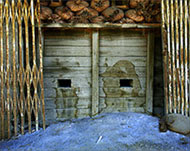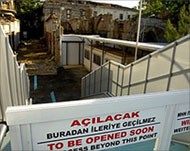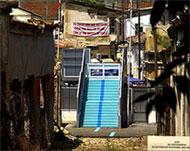A deep and abiding scar in Cyprus
It stretches for 180km across the heart of Cyprus.

In some places, it widens out to swallow up whole villages, while in another sector of the island it narrows to the width of an alley, a running scar straight through the capital, Nicosia.
This is the UN patrolled buffer zone. For the last 32 years, its sand bags, gun emplacements and rusting oil drums have stood as a monument to invasion and inter-communal violence.
It is watched over night and day by Greek Cypriot National Guardsmen on one side and Turkish and Turkish Cypriot soldiers on the other. The two hostile armies stand often no more than a few metres apart.
“Imagine,” says Agis Kleanthos, chairman of the Cyprus Stock Exchange and a supporter of the party of Thassos Papadopolous, the Greek Cypriot president.
“There is a Turkish Cypriot soldier on duty in his post at one end of Ledra Street. He spends all day looking down the barrel of a gun at a Greek Cypriot National Guardsman at the other end of the street.
“Then, he goes off duty, walks to the crossing point round the corner, goes over to the Greek Cypriot side, comes up behind the Greek Cypriot guardsman and says ‘Hi! Remember me? How about a drink?’ Nowadays, it’s quite possible for him to do this.”
But despite safe passage in recent years and efforts to bridge the divide, emotions anchored in history have kept the barricades up.
Crossing points opened
Since the Turkish Cypriots unilaterally opened up crossing points on their side of the buffer zone in 2003, anyone with Cypriot papers can travel freely from one side to the other.
 |
|
A Turkish firing position at the |
Since 2004, when Cyprus joined the European Union, anyone with an EU passport has been able to do likewise.
From the frontline on Nicosia’s Ledra Street, where at the Greek Cypriot barricade, the slogan “Nothing is gained without sacrifice, or freedom without blood” is prominently displayed, it is a simple five minute stroll around the corner to the crossing point and over to the Turkish Cypriot side.
At the crossing point too, every morning, hundreds of Turkish Cypriot construction workers cross over to the Greek Cypriot side to work, often doing so without even bothering to show their ID cards to the Greek Cypriot police at the crossing checkpoint.
At the same time, many Greek Cypriots go north.
“It’s cheaper over there,” says Vangelis Papayannis, a 20-year old IT worker. “Especially for things like haircuts, or getting your clothes or shoes repaired, or made, even.”
Yet despite the ease of passage, in many ways the division still remains.
Psychological divide
Ozdil Nami, a Nicosia member of the Turkish Cypriot parliament, which sits in the internationally unrecognised Turkish Republic of Northern Cyprus, points out that “trade across the buffer zone is only about $150,000 a month”.
“It’s not a lot – it could be much more, considering the potential,” he says.
|
“When the [Turkish] army came here, we were at least safe from the Greeks, who wanted to throw us all into the sea” Kemal Albeyoglu, |
Indeed, even though passage across the geographical divide is easy enough nowadays, the psychological and political divide remains far more daunting to overcome.
Since Turkish troops invaded the island in July 1974, after a coup d’etat by ultra-nationalist Greeks, Cyprus has been de facto divided between a Turkish Cypriot northern third and a Greek Cypriot southern two-thirds.
While older Greek Cypriots often look back to life before 1974 as a golden era, many Turkish Cypriots recall life on the island before then as a time when they, as a minority, were constantly in fear of ethnic cleansing by the Greek Cypriot majority.
“When the [Turkish] army came here,” says Kemal Albeyoglu, a long time resident of Nicosia, now retired, “we were at least safe from the Greeks, who wanted to throw us all into the sea.”
Much of the land and property in the north was owned by Greek Cypriots, who fled the Turkish invasion.
Many people who fled are still unaccounted for since those dark times. At the Ledra Street barricade, the faces of many of those missing since 1974 still look down from posters and commemorative displays on curious tourists and passers by.
“I would never go to the north, even though my house is there,” says Maria Christoforous, a 60-year old Greek Cypriot refugee from Kyrenia, known to the Turks as Girne, on the island’s northern coast.
“I don’t want to have to show my passport to cross into my own land.”
Fear, suspicion
While the Greek Cypriots do not recognise the buffer zone as a frontier, the Turkish Cypriots see it as the international border of their unrecognised state.
|
“I would never go to the north, even though my house is there. I don’t want to have to show my passport to cross into my own land” Maria Christoforous, 60, Greek Cypriot refugee from Kyrenia |
It has been three years since the crossings were opened, but about half of all Greek Cypriots have not travelled north, even though they are free to do so.
Trade with Turkish Cypriots is also still frowned on.
“Last year, there was a trade fair on the Greek side,” says Nami. “Some 40 Turkish Cypriot industrialists went, but this year it was down to 12.
“Neither this year nor last year did they get any orders at all. It’s not about prices or quality of goods – it’s beyond that: It’s politics and emotions.”
Such anxieties about the other side are never clearer than at the buffer zone itself, and back at the Ledra Street barricades.
“The Greek Cypriots have been happy to have crossing points opened elsewhere, but not here, on Ledra Street,” one international diplomat told Aljazeera.net on condition of anonymity.
“The Turkish Cypriots have always believed that too: That the Greek Cypriots will never be able to take down their barricade on this street, because it’s so symbolic of everything they have suffered, of the division and loss of their city.”
Building bridges
 |
|
The bridge from the Turkish |
Now though, looking through the gun slits at the Greek Cypriot barricade, across the wasteland of shot up buildings, there is an unfamiliar sight.
“We were determined to reunite this city,” says Nami. “So, over the objections of our own army, we built a bridge.”
Just before last Christmas, in a piece of timing aimed at the mainly Orthodox Christian Greek Cypriots by the largely Muslim Turkish Cypriots, the city authorities in the north constructed a passenger bridge over the top of their barricade and down into the buffer zone.
The bridge goes over the wall put there in 1974, and even over the heads of Turkish army patrols.
But the intended effect was not achieved.
“We thought the Greek Cypriots would be happy with this gesture,” continues Nami. “But instead they were furious.”
Step backwards
Kleanthos says: “This was a real step backwards. Opening the crossing together is one thing, but for them to just do it politicises the move.
 |
|
The bridge from the Greek |
“There’s also a problem because the Turkish army is still there and would still be patrolling.”
Brian Kelly, spokesman for the UN Cyprus forces: “It was supposed to become a bypass for the divisions between the Turkish and Greek Cypriots, but instead it became an impasse.”
So the buffer zone barricades on Ledra Street remain – the symbolic power of the observation posts and razor wire far greater than the military function of the ramshackle frontline.
Meanwhile, in the evening light, the Turkish Cypriot workers return to their homes in the north. Passing the other way are Greek Cypriot shoppers and European tourists returning from their day trips in the north.
The two worlds pass by within a few metres of each other – and within a few metres of the first lines of sand bags and trenches.
Yet their eyes seldom meet.
Photos By Jody Sabral